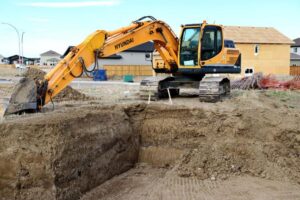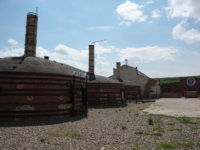Skyrocketing lumber prices increasing building costs
By Al Beeber on May 1, 2021.
 Herald photo by Al Beeber
Even with lumber prices much higher than last year, home construction season is well underway in Lethbridge.
Herald photo by Al Beeber
Even with lumber prices much higher than last year, home construction season is well underway in Lethbridge.LETHBRIDGE HERALDabeeber@lethbridgeherald.com
Builders, renovators and do-it-your-selfers can expect to pay more if they need lumber for any projects this year.
Lumber prices have skyrocketed since last summer and no break is on the immediate horizon.
Brad Hoover, financial manager at Logic Lumber and a director of BILD Lethbridge, said the spike started last August after prices tanked in March, April and May of 2020 due to COVID.
Board foot prices went from $400-$600 per thousand board feet to well over $1,000.
According to the Canadian government website, as of April 23, 2X4 eastern spruce-pine-fir was selling for $1,645 per thousand board feet in Canadian dollars, up substantially from the 52-week average of $1,030. The weekly price jumped from $1,540 on April 16.
The price for 2X4 kiln-dried western spruce-pine-fir #2 and better in U.S. dollars was $1,330 per thousand board feet on April 23 compared to $1,210 on April 16. The 52-week average is $773.
The price for 2X4 kiln dried western spruce-pin-fir Utility #3 was, in U.S. dollars, $1,160 per thousand board feet on April 23 compared to $1,050 on April 16. The 52-week average was $639.
Weekly panel prices, also in U.S. dollars, for composite on April 23 was $1,371 per thousand board feet compared to a 52-week average of $756.
Other types of panel also saw massive jumps.
“All of North America went into a wait-and-see kind of thing” when the pandemic hit, said Hoover with some lumber supply companies not even being sure if they could keep their doors open.
“But in June and July it started to ramp up.” And futures, said Hoover, are strong for July and August.
With the building season now getting into full speed, those higher prices will have to be paid if residential and commercial projects are going to proceed. This means more money coming out of the customers’ pockets.
The higher prices, however, also support jobs and according to Hoover, 19,500 jobs in Alberta are directly tied to the lumber industry. Another 2,5000 jobs are spinoffs.
“It affects customers and makes things more expensive but it contributes to jobs. A very strong housing demand is good for Canada,” said Hoover.
Mills, he said, are operating at capacity and can’t just ramp up production at the snap of someone’s fingers.
“They need more support systems; they can’t just produce 40 or 50 per cent more capacity.”
On April 29, according to the Canadian Press, Canfor Corp. posted a $427.8 million first-quarter profit, compared to a loss in 2020.
In the U.S., new home sales surged more than 20 per cent in March, reaching the highest level since 2006. And the U.S. industry, said Hoover, dictates the Canadian market.
While the usual waiting list for lumber shipments is two or three weeks, said Hoover, his company is now looking at August for stock to reach Lethbridge.
Dave Jackson of Lealta Building Supplies says “it’s a real juggling act to make sure we have inventory,” adding some materials have been on order for 16 weeks.
“These are stressful and challenging times,” said Jackson adding “we’re shockingly busy” despite the prices.
He suggests with COVID keeping more people working at home, many people might be taking on projects such as fences, decks and garages.
And he says suppliers aren’t making more money contrary to what some customers may think.
“My margins haven’t changed; just my costs have,” said Jackson who spends hours each day looking at lumber prices.
“It’s a difficult situation and as fast as it (price) goes up, it can go down that fast.”
An example of how fast prices have risen can be seen in the cost of brown treated fence boards, says Jackson.
In 2019, one board would have cost a customer $4.75 That same board today costs $8.15, a price increase of 42 per cent.
“I’ve never seen anything like this in 42 years,” he said of the pressure COVID has caused the market. And part of that pressure is due to plants being closed at times due to outbreaks of the virus which temporarily shut production.
Echoing Hoover’s statements, he reiterates that the Canadian market is driven by demand south of the border.
“The lumber market, plywood OSB, it’s all based on the amount of U.S. housing starts,” he says.
Follow @albeebHerald on Twitter
4-3



